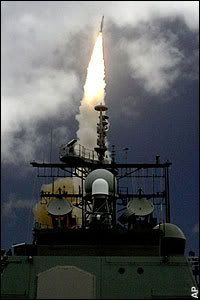
(picture from The Telegraph)
Hit or miss?
The Pentagon says it has to shoot down a malfunctioning spy satellite because of the threat of a toxic gas cloud. Space security experts are calling the rationale highly unlikely. "Having the US government spend millions of dollars to destroy a billion-dollar failure to save zero lives is comedic gold," one tells DANGER ROOM.Hmmm... I wonder if they have an explosive already on board the satellite so they can claim they shot it down even though they will miss by a mile. That will show the Chinese!Yesterday, Deputy National Security Advisor James Jeffrey said the satellite's tank full of hydrazine rocket propellant was the main reason the military was planning to blast the orbiter. There's a small but real risk that the hydrazine tank could rupture, releasing a "toxic gas" over a "populated area," causing a "risk to human life."
But, as we noted yesterday, Joint Chiefs of Staff Vice Chairman Gen. James Cartwright cast the threat from the satellite in much less dire terms. Even if the hydrazine were released, he noted, the effects would likely be mild -- akin to chlorine gas poisoning, which can cause burning in the lungs, and elsewhere. The area affected would be "roughly the size of two football fields [where you might] incur something that would make you go to the doctor."
And that doesn't sound like much of a risk at all.
Especially when you consider that several other hydrazine-filled object have come crashing down to Earth. Not only did the space shuttle Columbia have a similar tank, which survived re-entry, with no toxic gas cloud. Several other hydrazine-laced objects have also crashed into the atmosphere, with no ill effects. Space researcher Ed Kyle notes that there were 42 major reentry objects for 2007, including 9 satellites -- at least one of which contained a form of hydrazine, UMDH (unsymmetrical dimethylhydrazine).
Obviously, I bet they'll miss. And will lie about it.
Update 2/17. Now the Russians are involved:
Moscow, Russia (AHN) - Russia has accused the United States of testing an anti-satellite weapon system as the Pentagon prepares to shoots down a broken spy satellite.Update 1/17 11:30pm:
The pentagon has not given enough reasons to support its plan of smashing down the satellite.
"There is an impression that the United States is trying to use the accident with its satellite to test its national anti-missile defense system's capability to destroy other countries' satellites," Russia's Defense Ministry said in a statement, according to the Associated Press.
According to a report, spy satellite USA 193 should be visible in sky around the southeastern horizon before it is destroyed.
Jeffery of Arms Control Wonk:
Holding the aside the politics of this — which are terrible — the briefing on debris risk left me cold. I have to say that I am very, very uneasy about this decision — our missile defense tests have been heavily scripted to minimize debris creation and modeling of debris creation isn’t an exact science.
[snip]
1. The intercept will occur at 240 kilometers (130 nautical miles)
2. The mass of the satellite is 2,300 kg (5,000 pounds)
3. The mass of the interceptor is 20 kg. (From CBO)
4. The closing velocity will be 9.8 km/s (22,000 mph), suggesting a virtually head-on collision.
Other pertinent observations. At 240 km, the satellite should be traveling 7.8 km/s; the SM-3 has a burnout velocity of 3 km/s.
I am very worried about the debris creation — particularly the debris that the light-weight interceptor will kick into higher orbits when it hits the massive (bus-sized) satellite. Thnk, as Geoff Forden suggested, of a ping pong ball hitting a superball.
Virtually all the debris should come down quickly. Cartwright said 50 percent would come down within two orbits, with the rest coming down in weeks and months. That seems plausible, at first blush.
But those two orbits could be hairy and some of the debris will remain in orbit. Michael Griffin, NASA Administrator, said there are “good times and bad times” to conduct the intercept, based on the position of the ISS but that “bad times are not all that bad” comparing the risk to an order of magnitude lower than flying the shuttle.
Last I checked, the PRAN for the shuttle was 1 in 100. Extrapolating, there would be only a 1 in 1000 chance of wiping out the ISS.
No comments:
Post a Comment